






DEAD NECK SAMPSON'S ISLAND RESTORATION
Barnstable Clean Water Coalition and the community have done a great job in their efforts to protect the threatened and endangered birds that nest on Dead Neck Sampson's Island (DNSI). During the summer months it is important not to disturb the nesting sites. Please be respectful of the rules and fencing. During this time it is important to remember not to bring your dog to the island, as they are not allowed since they can disturb or injure the birds. If everyone can follow the rules and keep away from certain areas we can continue to keep the island open to visitors.
Dead Neck Sampson's Island Report
Maps from 2023


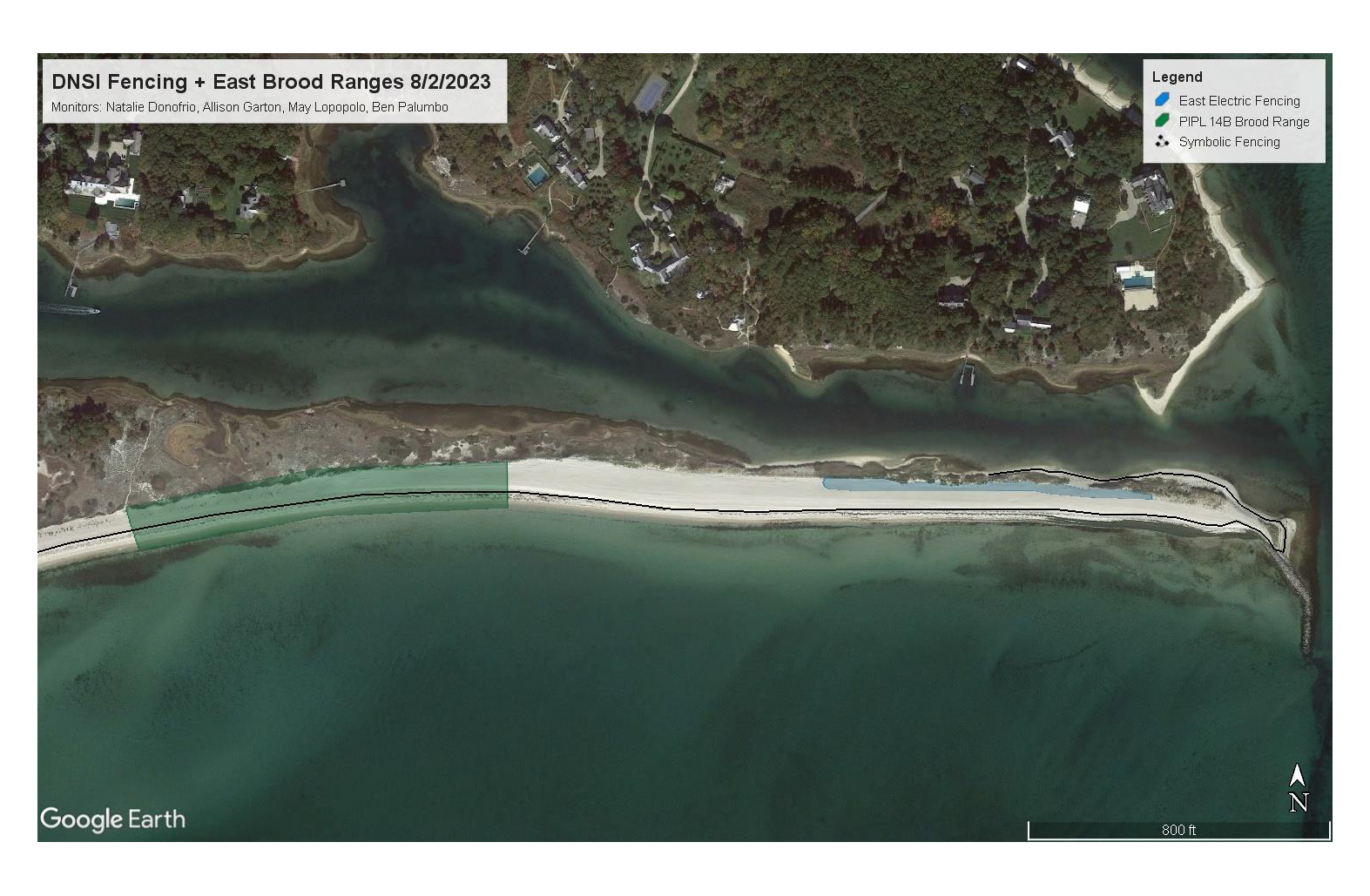
Managements of DNSI
We may be the Barnstable Clean Water Coalition now, but up until spring 2017, this organization was known as Three Bays Preservation, Inc. with a mission to preserve, maintain and protect the 12,541-acre watershed that encompasses North, West and Cotuit Bays. Here is how Three Bays Preservation came to be.
In the mid 1990’s, residents came together to preserve Dead Neck Island, a barrier island located south of Oyster Harbors. Paul Mellon, the original owner of the island, had passed away and a long-range plan for Dead Neck was needed. Several of these residents banded together in 1998 to form Three Bays Preservation and develop an ambitious project that combined dredging area channels and using the dredge spoils to help rebuild and maintain the island. Almost 300,000 cubic yards of sand have been deposited on the island over the past 15 years. Not only has this sand been useful for beach nourishment, it also has been used to create critical nesting habitat for endangered coastal shorebirds, including Least Terns, Common Terns and Piping Plovers.
Maintaining the integrity of the island has been a constant, ongoing process. Due to our active role in helping to preserve Dead Neck Island, Three Bays Preservation was honored to have Dead Neck Island donated to us in 2004 by Rachel Mellon, Paul Mellon’s widow. BCWC continues to maintain the island and manage it as a nature sanctuary per the request of the Mellon family.
Over the years, erosion and longshore drift has caused Dead Neck Island to merge with adjacent Sampson’s Island forming the barrier beach system now known as Dead Neck Sampson’s Island (DNSI). BCWC works closely with Massachusetts Audubon’s Coastal Waterbird Program staff to monitor and ensure protection for the nesting shorebirds on DNSI, which is designated an Important Bird Area. Everyone is welcome to visit this nature sanctuary, but we do ask that you follow these simple rules to assure the safety of the nesting birds and their chicks:
- Access to parts of the island are limited in spring and summer to protect nesting birds. Please stay out of nesting areas that are defined by symbolic fencing.
- Please stay off the dunes and do not disturb island vegetation. Many island plants have deep roots that stabilize the sand and prevent erosion.
- Pets are not allowed on the island. Please leave your dogs on the boat or at home.
- Kite flying is prohibited on DNSI. Kites resemble hawks and will alarm nesting birds.
- Lifeguards are not present on DNSI and swimming is at your own risk.
- Open fires are not permitted. If you use a grill, please take the charcoal with you and do not bury it in the sand.
- If you pack it in, please pack it out.
Ecology of DNSI
Barnstable Clean Water Coalition (BCWC) monitors wildlife and human activity on Dead Neck Sampson’s Island (DNSI), along with staff from the Coastal Waterbird Program of the Massachusetts Audubon Society (Mass Audubon). These efforts are especially important during the warmer months when the island receives an influx of visitors, where at the same time, locally-threatened Piping Plovers (Charadrius melodus) and Least Terns (Sternula antillarum) are actively nesting. These shallow nests, called scrapings, are extremely fragile and susceptible to frequent predation by other birds, foxes, and coyotes. The scrapings are typically found along the ocean-side of DNSI and are the reason for its seasonal closure. It is important not to disturb the nests and for visitors to stay away from active nesting sites marked with fencing by Mass Audubon. Additionally, to minimize disturbance to nesting sites and birds, dogs are not allowed on the island.
The 2018 season was disappointing for the Piping Plover and Least Tern populations that nest on DNSI. Between predators like American Crows and extreme high tides, the eight Piping Plover pairs observed on the island had a hard time building scrapings and producing a clutch of eggs. Only one plover chick survived to fully fledge. The Least Terns didn’t yield any nests, due to the high tides washing the scrapings away. We are hoping for a more successful summer next year, especially with the dredge spoils and enhanced nesting environment that will help create a more suitable nesting habitat for these shorebirds.
While out on the island, BCWC staff walk the shoreline and pick up litter and debris on the beach that is left by people, washed ashore by waves or carried there by wind. It is crucial to remove this litter as many species of wildlife can mistake certain pieces of trash, especially plastics, as a food source. Over time, plastic will photodegrade (decompose from exposure to light), which means sunlight will gradually break plastic down into tiny and in some cases microscopic pieces. Animals ingest or become entangled in plastic debris resulting in the deaths of many species of wildlife, including seabirds, sea turtles, whales, dolphins and fish.
The History of Dead Neck Island
This history of Dead Neck Island itself is integral to the history of the watershed we protect, as well as nearby Grand Island in Oyster Harbors. Throughout history, the two have been linked together with Dead Neck being an integral part of Oyster Harbors.
In 1658, Oyster Island (the first name for Oyster Harbors), along with Dead Neck, was reserved for the Indians that inhabited the area. Oyster Island was purchased from the Indians in 1737 for 517 English pounds by the Lovell family as a result of a lawsuit that put the Natives heavily in debt. It was then uninhabited for nearly two centuries being used only as salt works and pasture land. At that point in time, Dead Neck Island as we know it today did not exist. It was not an island then but a peninsula or “neck” of land that ran all the way from Dowse’s Beach to the end of Dead Neck with Sampson’s Island being a separate island altogether.
The first people who realized the potential for Oyster Island were Richard and Helen Winfield of Mount Vernon, New York. Over the course of forty years beginning in the late 1800’s until 1921, the Winfield’s acquired title to Oyster Island, now known as Grand Island, 54 acres of Little Island and 77 acres of Dead Neck Island. By 1925, the Winfield’s owned almost all of the property on all the islands except for a few lots that they had sold to eight families. It was then that they all realized that the island needed to be made more accessible, so they received permission from the Town of Barnstable to build a bridge from the mainland to Little Island in 1891. They also built a causeway over the marsh between Little and Grand Islands and constructed the first road on Grand Island. At the same time, Osterville residents were eager to open a channel for boats to travel from West Bay into Nantucket Sound.
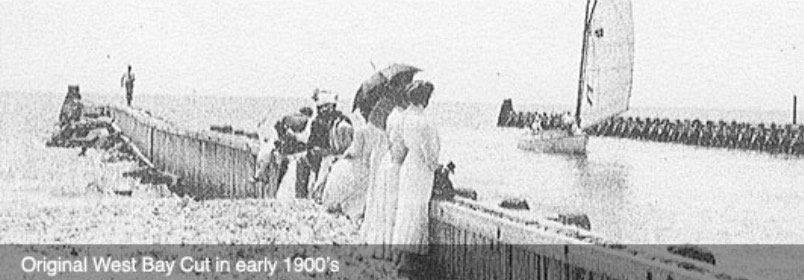
It wasn’t until the end of the 18th century that work began to make that “cut” from West Bay through the eastern end of Dead Neck to Nantucket Sound. Historically, farmers in the area took their cattle over to Oyster Island to graze by walking them across at a shallow point on Dead Neck called the “wading place” located across from Indian Point. At that time, they would have to wait for low tide so that the animals could make it over and back safely. All of the boat builders, most of whose companies still exist today, would have brought their boats down West Bay, along the Seapuit River and out the channel that was located between Dead Neck and Sampson’s Islands. Or they would go the other way around Oyster Island, west through North Bay, down the Cotuit Narrows, through Cotuit Bay and out the same channel that separated the islands.
The channel between the two islands was the main entrance and exit for Cotuit Bay having the deeper water necessary for the larger boats. This channel has long since been silted over and now forms a cove that is named either Cupid’s Cove if you’re a resident of Cotuit or Pirate’s Cove if you’re a resident of Osterville. Some of the locals wanted to make the cut at the end of Eel River, some people wanted the cut where is today, and another group didn’t want to have a cut at all. That group felt it would have a huge impact on the farmers who used the island and would merely create an obstruction in getting to their lands.
In 1901, the 100-foot cut buttressed by stone jetties on both sides was made. In 1902, $5,000 was allotted to the Town to dredge a three-foot channel out to deeper water in the Sound and through West Bay and up to the boatyards. It was then that Dead Neck truly became an island.
We wish to thank Jim Gould of Cotuit who contributed his knowledge of the history of Dead Neck and also to Zenas Crocker and his book “A History of Oyster Harbors to 1994”.

Bird Protection
Regulations
Why do we protect the birds on Dead Neck Sampson’s Island?
We are in the unique position of co-owning, with MA Audubon, a barrier island that is used as a staging and nesting area by migratory and shorebirds. There are fewer undeveloped beaches upon which these birds can nest. Protecting the birds and their habitat is our main priority.
Many of these birds are protected under the 1973 Endangered Species Act. This act provides penalties for taking, harassing, or harming endangered or threatened species and helps to protect their habitat.
Visit the complete law with the regulations and penalties
Fencing
As a result of these regulations, we keep a highly active presence on the island during the nesting and staging seasons. When the birds first arrive in the spring, MA Audubon's Coastal Water Bird Program staff erect symbolic fencing around potential nesting sites on Dead Neck Sampson’s Island. Not only is fencing put around actual nesting sites, but also potential feeding areas that the chicks would use after hatching. Some of the chicks, such as Piping Plover chicks, must feed themselves right after they hatch. Tern chicks however are fed by the parents.
Piping Plovers are very territorial and will chase off other plovers in their perceived territory, while terns like to nest in groups or colonies. As a result, electric fencing is erected around these colonies. The electric fencing acts as a predator barrier to protect the nests and the chicks. Coyotes frequent the island and one coyote can wipe out an entire tern colony in one night. While these colonies can be very noisy, the noise does nothing to deter the coyotes from trying to get into the enclosure. The electric fencing is sufficient enough to give the coyotes a good jolt should they try to enter into the colony, but not enough to kill them.
Several informational signs are on the island to explain why certain areas are fenced off . While you may not see any birds in the area, they could still be there. Most plovers will run away unless you come close to a chick or a nest. While terns will go on the attack and dive bomb if you venture too close, a plover will pretend to have a broken wing and will try to lure you away from the chick. Either way, your intrusion causes the bird a lot of undue stress and could endanger the survival of the chicks. If the adult is away from the nest trying to take care of you, the chick or egg can be left unattended under the baking sun and could die from excessive heat. And, if you happen to be in the area that they need to feed, a plover chick could actually starve from lack of food. We ask all DNSI visitors to respect the fencing, both symbolic and electric, and give these birds a chance for survival.
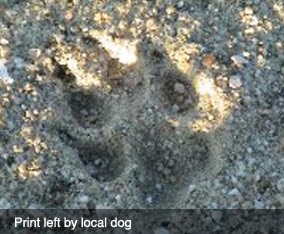
Kites and Dogs
We also ask that visitors do not fly kites while on the island. The nesting birds do not realize that these are only kites and perceive them as flying predators such as hawks.
The biggest problem we encounter on the island is the presence of dogs. While we are all dog lovers, we ask that you please leave your canine friends at home. Your dog could be the most friendly, benign animal on earth, but the birds do not know that. They see them as potential threats to the welfare of the chicks and themselves. They spend so much time trying to protect their nests that the birds suffer a lot of stress as a result. The mere presence of a dog can cause an adult to leave a chick or nest behind which could result in the death of that chick.
DNSI Birds
What kinds of birds call Dead Neck their home?
We have six different species of birds found on Dead Neck Sampson's Island: Piping Plovers, Least Terns, Common Terns, American Oystercatchers, Spotted Sandpipers and Willets.

Piping Plovers
Piping Plovers, Charadrius melodus, are about 7” in length with the male and female almost identical in appearance. They are small, stocky, light gray colored birds. The adult has yellowish orange legs, a black band across the forehead from eye-to-eye, and a black ring around the base of the neck. It runs in short starts and stops.
Plovers were once very common along the Atlantic coast during much of the 19th century but nearly disappeared due to excessive hunting for the millinery trade. They reached a peak of population during the 1940’s after the passage of the Migratory Bird Treaty Act of 1918. The current population decline is attributed to increased development and recreational use of beaches since the end of World War II. Piping Plovers are protected under the Federal and Massachusetts Endangered Species Act. They are listed as Threatened which means that without our protection, the population would continue to decline.
Piping Plovers usually arrive here on Cape Cod anywhere from late March to early May. The males arrive first to establish their territories and the females arrive later in the season. They are extremely territorial toward other plovers.
Plovers prefer to nest on broad open expanses of beach. The nest is usually just a small depression in the sand that they decorate with shells. It blends in so well with the sand and surrounding area that it can be very difficult to detect.
A female plover will lay a clutch of eggs, usually 4 eggs, and the eggs incubate for an average of 26 days. If the first nest is lost due to predation or the weather, the female will lay another clutch. The female can lay up to four clutches. Chicks will feed themselves from the day they hatch and roam great distances to find food. They usually eat small marine worms, insects, crustaceans, mollusks and other small marine animals. A plover chick will fledge at about 23 to 28 days. These plovers typically leave the area by late August and head south for winter along the beaches from the Carolinas to Florida and the Bahamas.

Common Tern
The Common Tern, Sterna hirundo, is a light gray and white, medium sized seabird about 14” in length. It has a black cap and a black tipped, red-orange bill during the nesting season and has red-orange legs.
These terns arrive here around the beginning of May. They form colonies by mid-May and begin elaborate courtship routines. The colonies can number from just a few birds to over 5,000 pairs. If you are an intruder into the colony, terns will dive bomb and defecate on you. They do not mate for life.
Terns prefer to nest in areas that are open enough to provide a clear view but have enough vegetation to provide shelter for the chicks. Females lay a clutch of 2-3 brownish-olive colored eggs that incubate for 23-27 days. Eggs are usually laid between May 4th and August 15th.
Unlike plovers, tern chicks are completely dependent upon the adults for their food. Adults will travel up to 15 miles to favorite fishing sites in search for food. Tern chicks usually fledge at about 28 days.
Adults and chicks gather together in ‘staging areas’ usually by mid-August to fly south to their wintering grounds that stretch from South Carolina through the Caribbean and to the coast of South America. In these staging areas, the adults and the chicks build up reserves of body fat to enable them to make the long flight.
Common Terns are protected by the Massachusetts Endangered Species Act and are listed as a species of Special Concern. Special Concern species are native species which have been documented by biological research to have suffered a population decline that could threaten the species. They occur in such small numbers with specialized habitat requirements that they could easily become threatened within Massachusetts if allowed to continue unchecked.
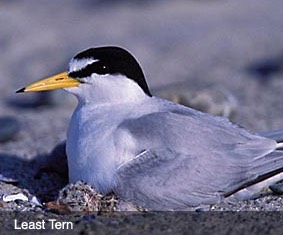
Least Tern
Least Terns, Sterna antillarum, are the smallest of the terns at just 9” in length. They closely resemble Common Terns. The male and female look very much alike. Least Terns arrive at their nesting sites around the 10th of May and quickly form colonies and begin their mating rituals.
Like the Common Terns, they can form large colonies with over 1,000 pairs. They also will form colonies with the Common Terns and Piping Plovers.
Least Terns prefer to nest in high areas with little or no vegetation. The preferred nesting sites are pebbly beaches or expansive sandy areas. The nests are shallow scrapes in the sand made by the females and decorated with shells and small pebbles. Nesting occurs mostly from Cape Cod north to Scituate and on the islands of Martha’s Vineyard and Nantucket.
The average size of the clutch is 2-3 eggs. Incubation lasts 20-23 days with both parents being involved. Adults will fly off the nest in response to disturbances and leave the chicks very vulnerable to overheating and predation, even if left for only a few minutes. Once the chicks hatch, they are totally dependent upon the adults for food.
Least Tern chicks usually fledge at 20-22 days of age. Once they have ‘staged’ with the other terns, they leave by mid-August and head south to winter on the coast from Mexico to South America. They are listed as species of Special concern by Massachusetts. Special Concern species are native species which have been documented by biological research to have suffered a population decline that could threaten the species. They occur in such small numbers with specialized habitat requirements that they could easily become threatened within Massachusetts if allowed to continue unchecked.

American Oystercatcher
American Oystercatchers, Haematopus palliates, are large shorebirds measuring 17-21” in length. They have a long, orange bill which they use for prying open bivalves (oysters, mussels, clams, etc.). They have yellow eyes and an orange eye ring with a black head and dark brown back and wings. The abdomen and portions of the wings and tail are white, while the legs are pale pink. The males and females are identical.
Oystercatchers nest in coastal habitats with very little vegetation. They lay their eggs in a shallow depression in the sand on beaches, shell mounds or dredge spoil islands. Oystercatchers are territorial and solitary nesters. By the mid 1800’s, Oystercatchers had all but disappeared from Massachusetts due to excessive hunting. However, with a little protection, by 1984 there were 42 pairs listed in the state. They are not currently protected by either the State or Federal Endangered Species Act.
Oystercatchers are among the earliest residents to appear on Cape Cod, arriving by mid-March. They soon begin to establish territories, often returning to the same site year after year. They have very elaborate courting rituals and are thought to mate for life.
Clutch size can range from 2-5 eggs. Incubation lasts about 27 days and both parents take turns. If an intruder wanders anywhere near the nest, the adult will leave the nest and wait anxiously nearby. Once the chicks hatch, the parents lead them to the security of denser vegetation nearby, close to the feeding territory. Young Oystercatchers are totally dependent upon the adults for their food and they usually do not feed themselves for several months.
The chicks usually fledge by 35 days. By the beginning of August, most of the young have fledged and the birds begin to gather in groups of 10-30 or more. By early October, most of the Oystercatchers have left for their wintering grounds along the mid-Atlantic coast.
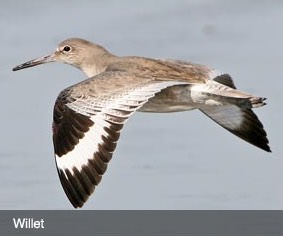
Willet
Willets, Catpotrophorus semipalmatus, are brown in color but when in flight they exhibit white markings on their wings. They are large birds averaging 13-16” in length. They have a long straight bill and long gray legs. The male and the female look alike.
The birds arrive in Massachusetts around May 1st and can be seen foraging in and around salt marshes, tidal flats and sandy beaches for worms, mollusks, fish and plant shoots.
The female chooses the nest site, a cup shaped and grass lined nest on the ground in a salt marsh or in the open on a sandy beach. The usual clutch size is 4 eggs and they incubate for 22-29 days.
When the eggs hatch, the chicks have short beaks, feed themselves and are camouflaged in a light brown colored down. Both parents incubate and help raise the young.
In late summer, large numbers of Willets stage together on the tidal flats prior to flying to their wintering ground on coastal beaches from the southern United States to Brazil.
Willets suffered drastic population decreases due to hunting in the late 1800’s and early 1900’s. This hunting resulted in willets being virtually non-existent north of Virginia. However, with full protection, they have rebounded. They only returned to breed in Massachusetts in 1976, and have taken a foothold ever since and currently are not protected by either the State or Federal Endangered Species Act.
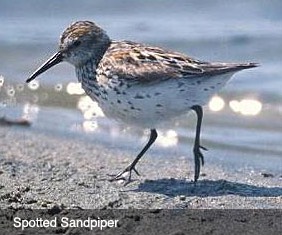
Spotted Sandpiper
Spotted Sandpipers, Actitis macularia, are common throughout the state of Massachusetts during the summer months.
The female arrives on Cape Cod first, usually around the end of April. By late May, males have arrived and paired up for breeding. The female is slightly larger than the male and is more aggressive in defending territory and courtship.
The nest is no more than a shallow depression in the dunes lined sparingly with grass. The usual clutch size is 4-5 eggs laid by the end of May and incubation lasts 20-24 days. The female will likely only lay one set of eggs, but she may re-lay if the first attempt fails. The male assumes most of the responsibility of incubating eggs and taking care of the young. Once the eggs hatch, the chicks are walking within 30 minutes.
Fledging occurs when the chicks are around 17 days old and they leave the family group. Fall migration to Central America and northern South America begins by mid-August and is complete by the end of September.
Spotted Sandpipers are quite common and are not protected by either the State or Federal Endangered Species Act.
